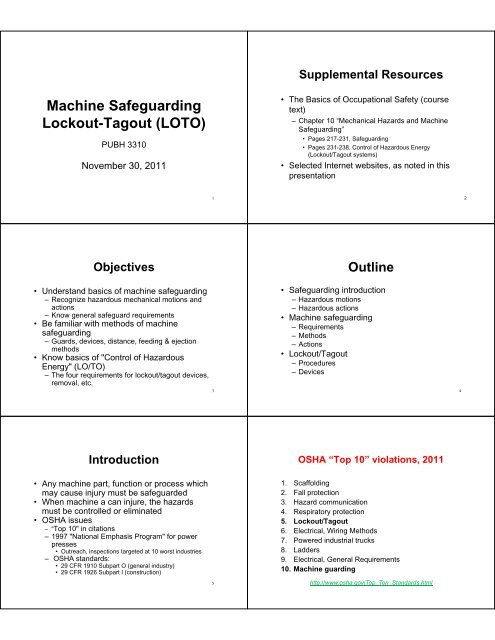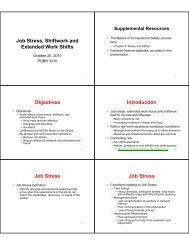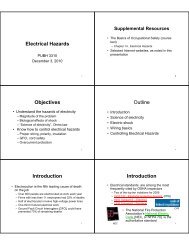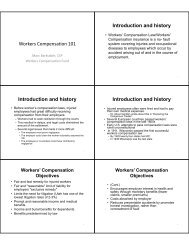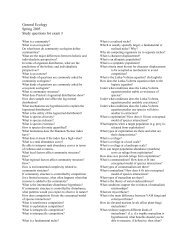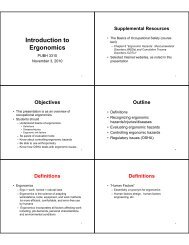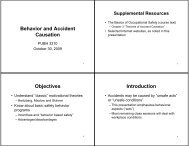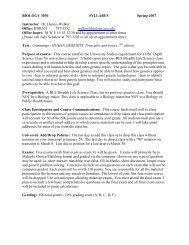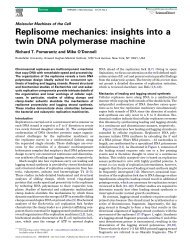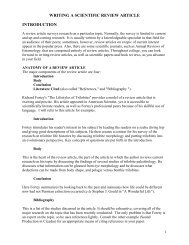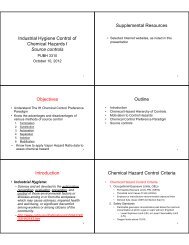Machine Safeguarding and Lock-out / Tag-out
Machine Safeguarding and Lock-out / Tag-out
Machine Safeguarding and Lock-out / Tag-out
You also want an ePaper? Increase the reach of your titles
YUMPU automatically turns print PDFs into web optimized ePapers that Google loves.
Supplemental Resources<br />
<strong>Machine</strong> <strong>Safeguarding</strong><br />
<strong>Lock</strong><strong>out</strong>-<strong>Tag</strong><strong>out</strong> (LOTO)<br />
PUBH 3310<br />
November 30, 2011<br />
• The Basics of Occupational Safety (course<br />
text)<br />
– Chapter 10 “Mechanical Hazards <strong>and</strong> <strong>Machine</strong><br />
<strong>Safeguarding</strong>”<br />
• Pages 217-231, <strong>Safeguarding</strong><br />
• Pages 231-238, Control of Hazardous Energy<br />
(<strong>Lock</strong><strong>out</strong>/<strong>Tag</strong><strong>out</strong> systems)<br />
• Selected Internet websites, as noted in this<br />
presentation<br />
1<br />
2<br />
Objectives<br />
• Underst<strong>and</strong> basics of machine safeguarding<br />
– Recognize hazardous mechanical motions <strong>and</strong><br />
actions<br />
– Know general safeguard requirements<br />
• Be familiar with methods of machine<br />
safeguarding<br />
– Guards, devices, distance, feeding & ejection<br />
methods<br />
• Know basics of "Control of Hazardous<br />
Energy" (LO/TO)<br />
– The four requirements for lock<strong>out</strong>/tag<strong>out</strong> devices,<br />
removal, etc.<br />
3<br />
Outline<br />
• <strong>Safeguarding</strong> introduction<br />
– Hazardous motions<br />
– Hazardous actions<br />
• <strong>Machine</strong> safeguarding<br />
– Requirements<br />
– Methods<br />
–Actions<br />
• <strong>Lock</strong><strong>out</strong>/<strong>Tag</strong><strong>out</strong><br />
– Procedures<br />
– Devices<br />
4<br />
Introduction<br />
OSHA “Top 10” violations, 2011<br />
• Any machine part, function or process which<br />
may cause injury must be safeguarded<br />
• When machine a can injure, the hazards<br />
must be controlled or eliminated<br />
• OSHA issues<br />
– "Top 10" in citations<br />
– 1997 "National Emphasis Program" for power<br />
presses<br />
• Outreach, inspections targeted at 10 worst industries<br />
– OSHA st<strong>and</strong>ards:<br />
• 29 CFR 1910 Subpart O (general industry)<br />
• 29 CFR 1926 Subpart I (construction)<br />
5<br />
1. Scaffolding<br />
2. Fall protection<br />
3. Hazard communication<br />
4. Respiratory protection<br />
5. <strong>Lock</strong><strong>out</strong>/<strong>Tag</strong><strong>out</strong><br />
6. Electrical, Wiring Methods<br />
7. Powered industrial trucks<br />
8. Ladders<br />
9. Electrical, General Requirements<br />
10. <strong>Machine</strong> guarding<br />
http://www.osha.gov/Top_Ten_St<strong>and</strong>ards.html
Where Mechanical Hazards<br />
Occur<br />
• Point of operation<br />
– Cutting, punching, etc.<br />
• Power transmission apparatus - components<br />
which transmit energy<br />
– Belts, flywheels, pulleys, connecting rods, chains,<br />
gears, cams, cranks, etc.<br />
• Other moving parts<br />
– Feed mechanisms, auxiliary parts, etc.<br />
7<br />
• Rotating motion<br />
– Couplings,<br />
flywheels, gears,<br />
shafts<br />
– Nip points<br />
• Opposite rotation<br />
(gears)<br />
• Between rotating<br />
<strong>and</strong> tangentially<br />
moving (belts <strong>and</strong><br />
pulley)<br />
• Between rotating<br />
<strong>and</strong> fixed parts<br />
Hazardous Motions<br />
Rotating couplings<br />
<strong>and</strong> shafts<br />
Nip points<br />
8<br />
Hazardous Motions<br />
• Reciprocating motion<br />
– Back-<strong>and</strong>-forth, up <strong>and</strong><br />
down<br />
• Transverse motion<br />
• Point of Operation<br />
– Cutting<br />
– Punching<br />
Hazardous Actions<br />
9<br />
10<br />
• Point of<br />
Operation<br />
(cont.)<br />
– Shearing<br />
– Bending<br />
Hazardous Actions<br />
Safeguard Requirements<br />
• Prevent contact with the hazard<br />
• Secure<br />
– Durable, firmly attached, not easily defeated or<br />
removed<br />
• Protect moving parts from falling objects<br />
• Create no new hazards<br />
• Create no interference to impede workers<br />
• Allow safe lubrication of the machine<br />
11<br />
12
<strong>Machine</strong> <strong>Safeguarding</strong><br />
Methods<br />
• Guards<br />
–Fixed<br />
• No moving parts<br />
– Interlocked<br />
• Mechanism stops when guard<br />
is open<br />
<strong>Machine</strong> <strong>Safeguarding</strong> Methods<br />
• Guards<br />
– Adjustable<br />
• Accommodate different stock sizes<br />
– Self-adjusting<br />
• Stock moves the guard<br />
Fixed guard with inspection panel<br />
Guard<br />
Adjustable<br />
Guard<br />
Self-adjusting guard<br />
with interlock<br />
13<br />
14<br />
<strong>Machine</strong> <strong>Safeguarding</strong><br />
Methods<br />
• Devices<br />
– Presence sensing<br />
• Photoelectric,<br />
radiofrequency,<br />
electromechanical<br />
Presence sensing devices at USU library<br />
Pressure sensitive mats<br />
Robotic book retrieval system<br />
15<br />
Optical sensor<br />
16<br />
<strong>Machine</strong> <strong>Safeguarding</strong><br />
Methods<br />
• Devices<br />
– Restraint (passive)<br />
• H<strong>and</strong>-feeding tools to<br />
position work<br />
– Pullback (active)<br />
Pullback<br />
device<br />
Pullback<br />
Adjustable<br />
wrist<br />
straps<br />
Passive restraint<br />
Safety tongs<br />
17<br />
18
<strong>Machine</strong> <strong>Safeguarding</strong><br />
Methods<br />
• Devices<br />
– Safety controls<br />
• Safety trip control<br />
– Shuts off machine if<br />
someone pushes or pulls<br />
the safety trip<br />
Safety trip rod<br />
<strong>Machine</strong> <strong>Safeguarding</strong><br />
Methods<br />
• Devices<br />
• Safety controls<br />
– Two-h<strong>and</strong><br />
control, twoh<strong>and</strong><br />
trip<br />
– Obliges the<br />
operator to<br />
remove their<br />
h<strong>and</strong>s from<br />
the point of<br />
operation<br />
Two-h<strong>and</strong> control<br />
Safety stop switch 19<br />
20<br />
http://www.y<strong>out</strong>ube.com/watch?v=7_PfxZMLP6o<br />
<strong>Machine</strong> <strong>Safeguarding</strong><br />
Methods<br />
• Devices (cont.)<br />
–Gates<br />
• Movable barrier<br />
that must be<br />
closed for the<br />
machine to<br />
operate<br />
Safety gate<br />
(with interlock)<br />
<strong>Machine</strong> <strong>Safeguarding</strong><br />
Methods<br />
• <strong>Safeguarding</strong> by<br />
Location/Distance<br />
– Hazardous locations are<br />
inaccessible during operation<br />
• Feeding <strong>and</strong> ejection<br />
methods to improve safety<br />
– Avoid need for operator to<br />
place h<strong>and</strong>s in danger area<br />
Safety gate <strong>and</strong> interlock at<br />
USU library<br />
21<br />
22<br />
Automatic feed<br />
<strong>Lock</strong><strong>out</strong>/<strong>Tag</strong><strong>out</strong><br />
<strong>Lock</strong><strong>out</strong>/<strong>Tag</strong><strong>out</strong><br />
• NIOSH investigated 152 deaths (1982-1997) that<br />
occurred during installation, maintenance, service, or<br />
repair tasks on or near machines, equipment,<br />
processes, or systems:<br />
– 82% from failure to completely de-energize, isolate, block,<br />
<strong>and</strong>/or dissipate the energy source)<br />
– 11% from failure to lock<strong>out</strong> <strong>and</strong> tag<strong>out</strong> energy control devices<br />
<strong>and</strong> isolation points after de-energization<br />
– 7% from failure to verify that the energy source was deenergized<br />
before beginning work<br />
• 20% of deaths among UAW members (1973-1995)<br />
caused by inadequate hazardous lock<strong>out</strong>/tag<strong>out</strong><br />
procedures<br />
23<br />
• OSHA Control of Hazardous Energy<br />
(<strong>Lock</strong><strong>out</strong>/<strong>Tag</strong><strong>out</strong>, or “LOTO”), 29 CFR<br />
1910.147<br />
– 1989 st<strong>and</strong>ard<br />
– 3 million workers at highest risk<br />
– 122 annual deaths, 28,400 lost time injuries<br />
– 2% of workplace deaths in affected industries<br />
– Applies where unexpected startup could injure<br />
24
<strong>Lock</strong><strong>out</strong>/<strong>Tag</strong><strong>out</strong><br />
Energy Control Program<br />
• Equipment must be de-energized <strong>and</strong> locked<br />
or tagged for servicing or maintenance<br />
operations<br />
– Guards or other safety devices are removed<br />
– Employee places any body part into point of<br />
operation, equipment, a danger zone associated<br />
with the machine cycle<br />
– Exception for cord-<strong>and</strong>-plug <strong>and</strong> "hot tap"<br />
operations<br />
– Not for minor servicing that is r<strong>out</strong>ine, repetitive<br />
<strong>and</strong> integral to production<br />
• New or modified equipment must be capable<br />
• Energy control program<br />
– Where unexpected energizing, startup or release<br />
of stored energy could cause injury<br />
– Includes:<br />
• Documented energy control procedures<br />
• Employee training<br />
• Periodic inspections of procedures<br />
of being locked <strong>out</strong> 25<br />
26<br />
Energy control procedures<br />
• Energy control procedures<br />
– How procedure will be used<br />
– Steps to isolate, block <strong>and</strong> secure equipment<br />
– Steps for lock<strong>out</strong>/tag<strong>out</strong> devices<br />
– Verify effectiveness of controls (test equipment)<br />
<strong>Lock</strong><strong>out</strong>/<strong>Tag</strong><strong>out</strong> Devices<br />
• Four requirements for lock<strong>out</strong> <strong>and</strong> tag<strong>out</strong><br />
devices:<br />
1. Durable<br />
2. St<strong>and</strong>ardized<br />
3. Substantial<br />
4. Identifiable<br />
27<br />
28<br />
<strong>Lock</strong><strong>out</strong>/<strong>Tag</strong><strong>out</strong> Devices<br />
• Four requirements for lock<strong>out</strong> <strong>and</strong> tag<strong>out</strong><br />
devices (cont.):<br />
1. Durable<br />
• Withst<strong>and</strong> the environment<br />
• <strong>Tag</strong>s must not deteriorate<br />
2. St<strong>and</strong>ardized<br />
St<strong>and</strong>ardized locks<br />
• Color, shape, or size<br />
• <strong>Tag</strong>s with st<strong>and</strong>ard print <strong>and</strong> format<br />
<strong>Lock</strong><strong>out</strong>/<strong>Tag</strong><strong>out</strong> Devices<br />
• Four requirements for lock<strong>out</strong> <strong>and</strong><br />
tag<strong>out</strong> devices (cont.):<br />
3. Substantial<br />
• <strong>Lock</strong>s must withst<strong>and</strong> all but<br />
excessive force or unusual<br />
techniques, like bolt cutters or other<br />
metal cutting tools<br />
• <strong>Tag</strong>s must withst<strong>and</strong> 50 pound force<br />
St<strong>and</strong>ard format tag<br />
29<br />
Bolt cutters<br />
30
<strong>Lock</strong><strong>out</strong>/<strong>Tag</strong><strong>out</strong> Devices<br />
• Four requirements for lock<strong>out</strong> <strong>and</strong><br />
tag<strong>out</strong> devices (cont.):<br />
4. Identifiable<br />
• Clearly identify employee<br />
• <strong>Tag</strong>s must have a warning<br />
Energy-isolating devices<br />
• <strong>Tag</strong>s<br />
– For equipment that cannot<br />
be locked <strong>out</strong><br />
– <strong>Tag</strong>s may be used for<br />
lockable equipment only if<br />
"at least as effective" as<br />
locks<br />
– <strong>Tag</strong>s removed only by<br />
person that applied it<br />
– Legible <strong>and</strong> underst<strong>and</strong>able<br />
– Securely attached<br />
Label for a padlock<br />
<strong>Tag</strong> with warning <strong>and</strong><br />
employee name<br />
<strong>Tag</strong> with warning (employee name is on<br />
the other side)<br />
Using <strong>Lock</strong><strong>out</strong>/<strong>Tag</strong><strong>out</strong> Devices<br />
• Application<br />
– Shutdown equipment <strong>and</strong> apply device<br />
– “Render safe" stored or residual energy<br />
• Use blocks, discharge springs, bleed pressure, etc.<br />
– Verify isolation/deenergization<br />
• Try to operate the equipment<br />
• Test voltage, etc.<br />
Using <strong>Lock</strong><strong>out</strong>/<strong>Tag</strong><strong>out</strong> Devices<br />
• Removal of locks <strong>and</strong> tags<br />
– Inspect <strong>and</strong> work area, check around<br />
machine<br />
– Notify affected employees before<br />
starting equipment<br />
– <strong>Lock</strong>s <strong>and</strong> tags removed by<br />
employees that attached them<br />
• Special procedures when this is not<br />
possible<br />
Electrical lock-<strong>out</strong><br />
Valve lock-<strong>out</strong><br />
Valve lock-<strong>out</strong><br />
Other <strong>Lock</strong><strong>out</strong>/<strong>Tag</strong><strong>out</strong><br />
Requirements<br />
• Procedures required for:<br />
– Testing or positioning machines<br />
– Outside personnel<br />
– Group lock<strong>out</strong> or tag<strong>out</strong><br />
– Shift or personnel changes<br />
Group lock-<strong>out</strong> devices<br />
35<br />
For More Information<br />
• <strong>Safeguarding</strong> Equipment <strong>and</strong> Protecting Workers<br />
from Amputations,<br />
http://www.osha.gov/Publications/OSHA3170/osha31<br />
70.html or<br />
http://www.osha.gov/Publications/osha3170.pdf<br />
• OSHA machine guarding “e-tool”,<br />
http://www.osha.gov/SLTC/etools/machineguarding/in<br />
dex.html<br />
• Preventing Worker Deaths from Uncontrolled Release<br />
of Electrical, Mechanical, <strong>and</strong> Other Types of<br />
Hazardous Energy http://www.cdc.gov/niosh/docs/99-<br />
110/<br />
• OSHA <strong>Lock</strong><strong>out</strong>/<strong>Tag</strong><strong>out</strong> “Expert Advisor”,<br />
http://www.osha.gov/dts/osta/oshasoft/lotoplus.html<br />
36


